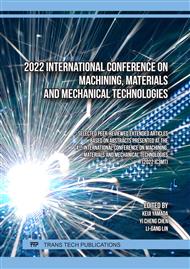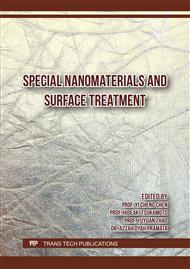[1]
Hai-Ping Tsui, Biing-Hwa Yan, Wei-Te Wu, Sheng-Tsai Hsua, (2007), "A study on stainless steel mirror surface polishing by using the electrophoretic deposition method," International Journal of Machine Tools & Manufacture, vol. 47, pp.1965-1970.
DOI: 10.1016/j.ijmachtools.2007.02.005
Google Scholar
[2]
Hai-Ping Tsui, Shih-Yu Hsu, (2022), "Study on Fe-based metallic glass micro hole machining by using micro-EDM combined with electrophoretic deposition polishing,"Processes,vol. 10(1), 96
DOI: 10.3390/pr10010096
Google Scholar
[3]
J. F. Aebersold, P. A. Stadelmann and M. Matlosz, (1996), "A rotating disc electropolishing technique for TEM sample preparation," Ultramicroscopy, pp.157-169.
DOI: 10.1016/0304-3991(95)00144-1
Google Scholar
[4]
Hryniewicz Tadeusz, (1994), "Concept of Microsmoothing in the Electropolishing Process", Surface & Coatings Tech., Vol. 64, No. 2, pp.75-80.
DOI: 10.1016/s0257-8972(09)90006-8
Google Scholar
[5]
J. E. Labarga, J. M. Bastidas and S. Feliu, (1991), "A Contribution to the Study on Electropolishing of Mild Steel and Aluminium Using Alternating Current," Electrochimica Acta, Vol. 36, No. 1, pp.93-95.
DOI: 10.1016/0013-4686(91)85184-9
Google Scholar
[6]
G. H. Sedahmed, M. S. Abdo and M. A. Kamal, (2001), "A Mass Transfer Study of the Electropolishing of Metals in Mechanically Agitated Vessels," Int. Comm. Heat Mass Transfer, Vol. 28, pp.257-265.
DOI: 10.1016/s0735-1933(01)00232-9
Google Scholar
[7]
Derek Pletcher and Frank C. Walsh, (1995), "Industrial Electrochemistry, " second edition, Blackie Acadmic & Professional. .
Google Scholar
[8]
S.J. Lee and et. al.,(2003), "The effects of electropolishing (EP) process parameters on corrosion resistance of 316L stainless steel," Journal of Materials Processing Technology, vol. 140, pp.206-210.
DOI: 10.1016/s0924-0136(03)00785-4
Google Scholar
[9]
Robert D.C,Ben S and Patrick A.O.,(1990), "electropolishing of stainless steel," PCMI Annual Meeting.
Google Scholar
[10]
P. Jemmely, and et. al.,(2000), "Electrochemical modeling of passivation phenomena in tribocorrosion," Wear, vol. 237, pp.63-76.
DOI: 10.1016/s0043-1648(99)00314-2
Google Scholar
[11]
C. H Wang, (2003), "The Effects of Convection on Electropolishing,"Yuan-Ze University in Partial Fulfillment of the Requirements for the Degree of Master of Science in Mechanical Engineering, Chungli, Taiwan.
Google Scholar



